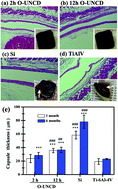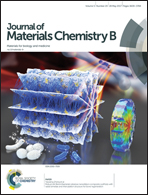Long term in vivo functional stability and encapsulation reliability of using ultra-nanocrystalline diamond as an insulating coating layer for implantable microchips†
Abstract
Thin ultra-nanocrystalline diamond (UNCD) films were evaluated for their use as encapsulating coatings for long-term implantable microchips. The ex vivo hermetic properties of UNCD coatings of various thicknesses and their reaction with tissues in vivo were investigated. Leakage current tests showed that the ∼300 nm thick coatings grown on microchips in (1% H2) Ar/CH4 plasma for 2 hours rendered the surface electrochemically inactive, i.e., the microchips showed an extremely low leakage current density (1.3 × 10−4 A cm−2 at ±5 V). The tests simulate the human body environment ex vivo. Six months after the implantation of the chips in mice, the leakage current density of the thin O-UNCD-coated chips was approximately 7.76 × 10−5 A cm−2 at ±5 V, which is lower than that of chips with a UNCD coating of 1.53 μm thickness deposited for 12 hours (1.71 × 10−4 A cm−2 at ±5 V). These results indicate that the thin coatings can effectively protect the implant from degradation in vivo. Moreover, the relationship between the surface properties of the carbon-based implants and the foreign-body response they elicit was established. Our results strongly indicate that the formation of a fibrous capsule surrounding the implants depend on the surface features of the implants (i.e., roughness, surface area, surface energy, and amount of absorbed fibrinogen) and on the amount of cytokines or chemokines secreted by the host through acute and chronic foreign-body reactions. Finally, oxygen-terminated UNCDs are promising candidates for use as encapsulating coatings without any additional surface modification or functionalization. They exhibit good bioinertness and hermeticity, thus contributing to the direct long-term protection of implantable microelectronic devices from chemical attack by bodily fluids in a physiological environment.



 Please wait while we load your content...
Please wait while we load your content...